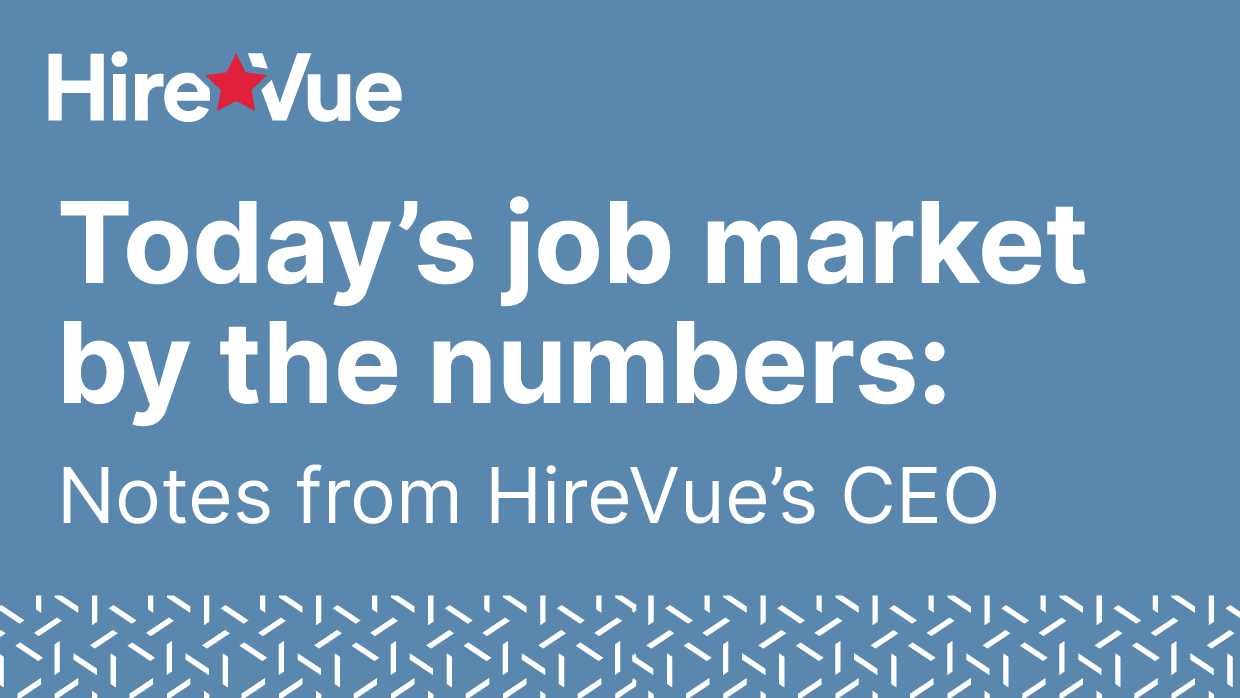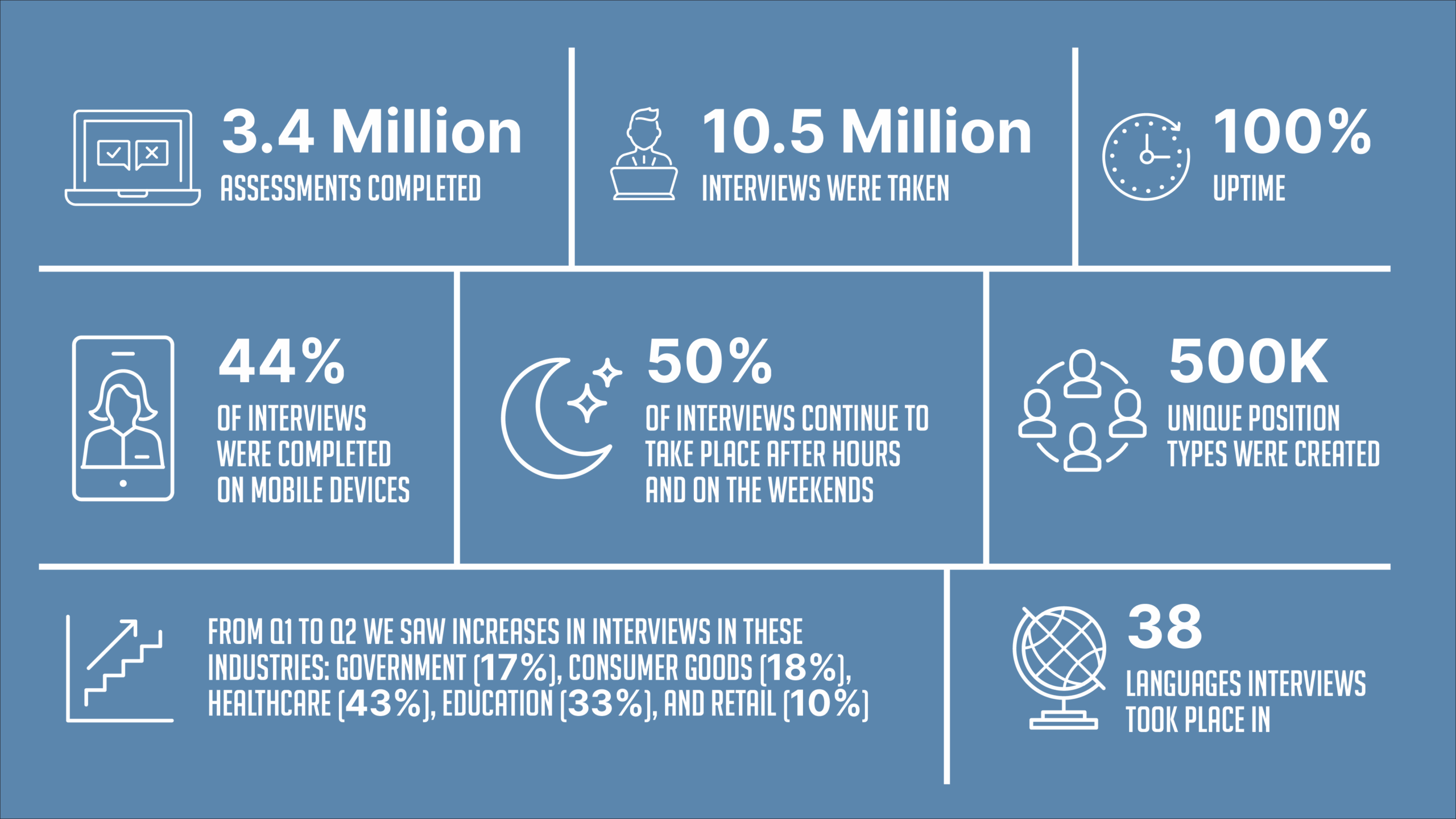Today’s job market by the numbers: Notes from Hirevue’s CEO

One of the most valuable exercises I do as a leader is sitting down to synthesize our company’s platform data and comparing it against what I’ve been hearing from customers and watching in the market. A deep understanding of macroeconomic trends is how our leadership team stays ahead of the competition with company-wide innovation; it’s how we’re able to give customers the strategic guidance they’ve come to expect when doing their workforce planning.
Based on what we’re seeing now, I’m making three observations and predictions for the rest of the year that I hope our customers and partners take to heart:
- the Great Resignation isn’t over
- worker empowerment and choice is here to stay
- seasonal workers aren’t one-time hires
HireVue by the numbers
For the first half of the year (January 1 – June 31st) we’re seeing incredible numbers coming out of our customer’s platform usage. What you see below is a reflection of the fact that the job market is still strong. There are great job opportunities available and companies are working hard to fill them with the best and brightest people by leaning into streamlined HR tech stacks:

*Note, we haven’t even finished data integrations from our acquisition yet, so I’m eager to see the kind of insights we gain when we have a full picture of our 1150+ customers for my next read out.
The Great Resignation isn’t over
I’m going to go out on a limb here and contradict what a lot of really brilliant folks are saying: the Great Resignation isn’t over. The truth is we’ve just gotten used to higher quit rates from workers who are unsatisfied and seeking better opportunities.
According to the U.S. Bureau of Labour Statistics May 2023 Turnover and Layoff Summary:
- There are still 9.8 million job openings
- The number of hires and total separations changed very little at 6.2 million and 5.9 million, respectively.
- Within separations, quits (4.0 million) increased, while layoffs and discharges (1.6 million) changed little.
Remember when 4 million quits made all of us take pause? There aren’t signs of this slowing down–we’ve just gotten used to a baseline of higher quits.
Resignations will continue, especially in hourly and high volume roles, which is why our customers are leaning into always-on hiring campaigns built on text messaging, chatbot communications, and on-demand interviews.
Worker empowerment and choice is here to stay
In a recent episode of The Daily, Ben Casselman describes how we’re in a period of mobilization for workers, which is evidenced very clearly in unionization:
We’ve seen unionization drives at Starbucks and at Amazon. We see strike activity, whether it’s the Hollywood writers strike that’s going on now or a UPS strike that’s looming on the horizon.
But we also see it not just in this classic organised labour way, but also just in the day-to-day activity and awareness of individual workers. I talk to a lot of low wage workers. And a lot of them tell me that this period has changed the way they think about their work and their role in the workplace.
As I was writing this post I received a news alert that leaders of the Hollywood union SAG-AFTRA, representing 160,000 television and movie actors, voted to strike with screenwriters who have already been picketing for over 70 days.
Make no mistake, the Great Resignation and empowered labour go hand-in-hand. Workers today are much more likely to leave a bad job in search of a good one. And while we don’t have wage data from our customers, I can tell you anecdotally that we’ve seen persistently higher interviewing and position creation amongst our customers who offer higher hourly wages.
Seasonal workers aren’t one-time hires
While we tend to speak of the workforce as a monolith, it’s important to remember that there are distinct demographics companies can and should tap into. Every year we help customers conduct massive seasonal campaigns, but companies need to stop thinking of these employees as temporary, rather they’re a reliable pool you can hire from season after season.
Hiring teenagers in particular was top of mind as I dug into data this quarter. We’re seeing interesting macro trends amongst this demographic that tells a story about our in-house numbers.
An increasing number of teens are working–33.6% of 16-19-year-olds are working this season, compared to 32.7% last year. They are a prime group for roles in leisure, hospitality, food and beverage (industries that are still fighting to fill headcount). Consider this, in May to June this year, HireVue saw several industry increases in hourly, customer-facing roles and less non-hourly. Roles that are perfect for teens with variable schedules:
Retail (-5% in non-hourly roles)
- Manufacturing (26% growth in hourly roles in June)
- Food and beverage (17% growth in hourly roles)
- Hospitality and Recreation (7% growth in hourly roles, -16% in non-hourly)
So what does this mean for companies looking for hourly, high-volume talent? It means you have a massive opportunity with teens, but your processes better be up to par. Teens grew up in the digital age, and they have expectations for the hiring process; you have to text them and offer mobile-friendly solutions. And then you need to keep them engaged for next season. Today’s summer warehouse help could be your next cyber security engineer.
Wrapping up the first half of the year
While we’re certainly seeing some cooling in hiring for a few sectors, I remain optimistic that hiring overall is robust. We get to see up close how over 60% of the Fortune 100 and 8 of the 10 largest federal agencies are hiring, and the outlook still looks positive from here.
Adopting the right hiring technology now can set your team up for success during the ups, downs and unexpected twists in an ever-changing market. Ready to bring your hiring to the next level? Request a demo today.



